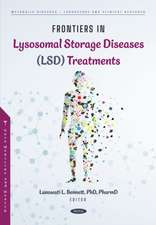Functional Insulin Treatment: Principles, Teaching Approach and Practice
Autor Kinga Howorka Traducere de K.M. Nelson Cuvânt înainte de M. Berger, J.S. Skyleren Limba Engleză Paperback – 15 ian 1996
Preț: 635.45 lei
Preț vechi: 668.89 lei
-5% Nou
Puncte Express: 953
Preț estimativ în valută:
121.59€ • 127.29$ • 100.61£
121.59€ • 127.29$ • 100.61£
Carte tipărită la comandă
Livrare economică 01-07 aprilie
Preluare comenzi: 021 569.72.76
Specificații
ISBN-13: 9783540603528
ISBN-10: 3540603522
Pagini: 240
Ilustrații: XX, 218 p. 29 illus.
Dimensiuni: 127 x 190 x 13 mm
Ediția:2nd ed.
Editura: Springer Berlin, Heidelberg
Colecția Springer
Locul publicării:Berlin, Heidelberg, Germany
ISBN-10: 3540603522
Pagini: 240
Ilustrații: XX, 218 p. 29 illus.
Dimensiuni: 127 x 190 x 13 mm
Ediția:2nd ed.
Editura: Springer Berlin, Heidelberg
Colecția Springer
Locul publicării:Berlin, Heidelberg, Germany
Public țintă
Professional/practitionerCuprins
1 Introduction.- 2 Overview of the Phases of Rehabilitation in Persons with Type I (Insulin-Dependent) Diabetes.- 2.1 Intermezzo 1: A Strategy for Failure — or How Not to Educate Patients.- 3 Basic Diabetes Education (Phase I of Rehabilitation).- 3.1 Insulin Action in Healthy Persons; Insulin Deficiency.- 3.2 Diet.- 3.3 Self-monitoring.- 3.4 Strategies for Insulin Treatment.- 3.5 Insulin.- 4 FIT Training (Phase II of Rehabilitation).- 4.1 Initial Algorithms, “K” and the Blood Glucose Target Value.- 4.2 Intermezzo 2: A Strategy for Failure — or How to Demotivate Even the Most Convinced Enthusiast.- 4.3 Introducing FIT in Practice.- 4.4 Pedagogical Aspects of Insulin Substitution: Transactional Analysis and “Insulin Games”.- 4.5 Is “Yielding to Temptation” All Bad?.- 4.6 Testing Algorithms for Correcting Blood Glucose (and Determining the Kidney Threshold for Glucose). Why?.- 4.7 Why fast?.- 5 Criteria for Functional Insulin Treatment.- 5.1 Basal Substitution.- 5.2 Prandial Insulin Substitution — Problems in Dosing Regular Insulin.- 5.3 Self-monitoring and Glycemic Control — Why Keep Records?.- 6 Hypoglycemia.- 6.1 Definition of Hypoglycemia.- 6.2 Increased Probability of Severe Hypoglycemia.- 6.3 Causes of Hypoglycemia.- 6.4 Prevention of Hypoglycemia.- 6.5 Treatment of Hypoglycemia.- 7 Hyperglycemia.- 8 Rules for Algorithm Modification.- 8.1 Global Changes in Insulin Requirement.- 8.2 Modification of Individual Algorithms.- 9 Physical Activity.- 9.1 Short, Sporadic Periods of Physical Activity.- 9.2 Prolonged Periods of Physical Activity.- 10 Pregnancy in Type I (Insulin-Dependent) Diabetes.- 10.1 Patient Education Concerning Diabetes and Pregnancy.- 10.2 Consequences for Treatment.- 10.3 Interdisciplinary Care for Pregnant Diabetic Women.- 10.4Special Aspects of Secondary Adjustment of Insulin Dosage During Pregnancy and Childbirth.- 11 Functional Insulin Treatment for Type II Diabetes.- 11.1 Characteristics of Treatment of Type II Diabetes.- 11.2 Covering Basal Insulin Requirements in Insulin-Treated Type II Diabetic Patients.- 11.3 Special Aspects of the FIT Training Program for Type II Diabetic Patients.- 11.4 How Can Weight Loss Be Reached with Type II Diabetes During Functional Insulin Treatment.- 12 Coping with Special Situations.- 13 Frequent Patient-Related Problems.- 13.1 Grief-Work in Persons with Diabetes.- 13.2 Inadequate Information.- 13.3 Failure to Adjust to the Realities of Diabetes.- 14 Frequent Physician-Related Problems.- 14.1 Communication Problems.- 14.2 Inability to Understand What Life Is Like for the Patient.- 14.3 Inadequate Information.- 15 The “Contras”.- 15.1 Contraindications for Functional Insulin Treatment.- 15.2 “Difficult” Patients.- 15.3 Intermezzo 3: A Strategy for Failure or How to Mess Things Up in the Outpatient Phase.- 16 Checklist for Continuing Care of FIT Patients (Phase III of Rehabilitation).- 16.1 The Patient’s Knowledge.- 16.2 Applying Knowledge; Practicability of Therapeutic Measures.- 16.3 Motivation.- 16.4 Acceptance of Diabetes.- 16.5 Metabolic Status.- 16.6 Late Complications.- 16.7 Comorbidity.- 16.8 Social Environment.- 16.9 The Patient’s Contact with the Diabetes Treatment Center, Physician or Diabetes Counselor.- 16.10 Humor.- 17 Review of Results and Experience.- 17.1 Patients.- 17.2 Follow-up.- 17.3 Results.- 17.4 Experience with FIT in Special Situations.- 18 Open Questions, Unsolved Problems and Limits of FIT.- 19 Epilogue.- References.- Appendix 1: Didactic Aspects of the FIT-Training Program.- Appendix 2: FIT — Initial Information forPatients.- Appendix 3: Nomogram for Generating the Initial Algorithms for FIT/Coauthors: H. Egger and H. Thoma.- Appendix 4: Selection of Available Human Insulins.- Appendix 5: Examples of Carbohydrate Units.
Textul de pe ultima copertă
The functional use of insulin is the most effective method of treatment of diabetes requiring insulin available today. This book of Functional Insulin Treatment, FIT, shows how to put it into practice. Previous diabetes education programs have adapted the patient's life style to the conditions of therapy. The goal of FIT is to avoid/delay late complications while tailoring the therapy to the life of the patient: whether with multiple daily injections or with controllable infusion, the diabetic person trained in FIT is able to dose her/his insulin according to its actual function, i.e., either for eating or for fasting or for correction of hyperglycemia, so that she/he achieves both, the target glycemic control and the freedom to fast or to eat whenever, whatever and how much she/he wants. Included are new strategies for patient motivation, new insulin analogs, management of nutrition in overweight, easy estimations of algorithms for starting functional use of insulin and everything that makes flexible treatment an indispensable solution for every interested self-responsible person who needs insulin.





















